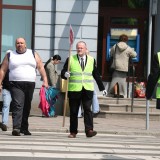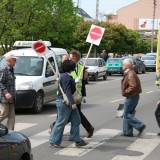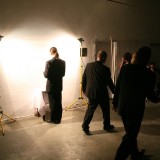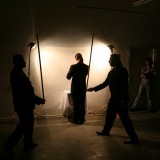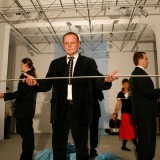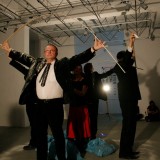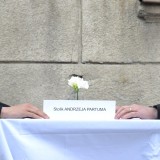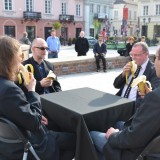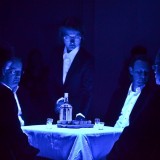Restauracja Europa
The Restauracja Europa Group emerged in the year 2000 and was founded by Piotr Gajda and Gordian Piec. The name of the group relates to the name of the restaurant at 4 Kościuszko Place in Piotrków Trybunalski – once the most refined restaurant in the area, with great cuisine and a tradition reaching to before WW2. The space ceased to be a restaurant in however for a few years after its closure, a couple of editions of the Interakcje Festival took place there organised by Piotr Gajda, Gordian Piec, Ryszard Piegza and Jan Świdziński.1
The Restauracja Europa Group has a artistic and curatorial focus. Its members – mainly Piotr Gajda and Gordian Piec every year organise the Interakcje festival which has become one of the largest and oldest festivals in Europe. During the last 15 years, a several hundred artists have participated in it, both renowned and emerging. From the very beginning, Interakcje was a non-institutional initiative, organised by the OFF Gallery Association. The artists present their actions promoting the idea of Interakcje in Poland and abroad. In 2008 they participated in the project “I AM/JESTEM – Polish performance art.” organised by the Stranmillis University Collage and the Artists Society BBeyond in Belfast and in 2011 they were in Madrid invited by the organisers of the independent Performance Art Festival Accion!MAD. They also visited Paris, Monza, Ostrava, Minsk and Brussels with their artistic activities and presentations.
The formula of the Restauracja Europa Group is open, so its format changes depending on the situation, the context of the moment or certain projects in which given members participate. The core of the group are Piotr Gajda and Gordian Piec and in their actions others artists have participated too, amongst them: Mariusz “Marchewa” Marchlewicz, Piotr Łaszek, Olga Nowakowska and Karina Poteralska.
The Restauracja Europa Group works in various media: performance, installation, photography, video, and also more traditional media such as painting or sculpture. Their events also includes poetry in their actions. To quote the members: The key element of creation is the moment in which we meet a variety of people in conjunction with the place where the action is presented. A fundamental aspect of functioning of the group is an open formula of membership and activity. The group actions are presented in a limited space which enables the artists to perceive each other’s experiences and interpretations. Individual actions research a dependence between the internal and the external, between the ego of the individual and the ego of the group.
Within the art of the Restauracja Europa group we can find the traces of Dadaistic practice and Fluxus actions. The most spectacular elements are the group performances. They wear the characteristic outfit of a black suit and tie and with this style, they make reference to the image of heroes from Quentin Tarantino’s movies.
Various props and elements of choreography which synchronises the movements and gestures of the artists are also important. It is a tradition for the group to present a performance during the Interakcje festival, which they host.
In 2007 they performed two actions – in a public space and in the gallery. In the first one, the artists wearing fluorescent vests with the festival’s logo accompanied every pedestrian crossing the street thereby referring to the action of helping children across the street by people dressed similarly. The spectacular action, which could be summarised as Małgorzata Butterwick and Monika Branicka wrote “it’s safer with art”, excellently reflected the idea of the festival – making contact with another human being, here an accidental viewer – a passer-by.2
In a performance in a gallery during the same festival, two situations happened simultaneously. Mariusz Marchewa Marchlewicz stood with his back towards the viewers in front of an empty table covered with a white cloth and read a text describing a lavish dinner. The text worked on two levels – the description of the table’s aesthetics and the etiquette, as well as description of emotions close to paranoia hiding under a conventional façade. When Marchewa read the text, the remaining artists (Gajda and Piec) balanced wooden poles on their fingers. Sometimes they were successful in their “acrobatic exercise”, sometimes they weren’t and it was a test for their abilities and the audience’s reflexes, since the poles were falling in various directions. The action with poles excellently corresponded with the text which balanced on the border between convention and madness. In a situation created by the group, there was no drama – only irony and the grotesque.3
In 2008 during the jubilee – 10th edition of the festival, they presented a very visual action which took place in a marked square field. Four artists participated in it, and each of them worked on “his” own side of the square and a female artist acted as a medium between them. The artists changed into their usual performing clothes, the elegant suits. Then they continued the same action – they played noughts and crosses, then raised boards sprinkled with white powder (which were there to define the square), and them broke them. The performance was finished with an explosion of confetti.
In 2013, during the 15th Interakcje festival, the group made three performances, each time evoking the history of the festival and the place with which the beginning of their work is associated. One of the actions took place next to the old restaurant building. The artists cleaned dirt from a plaque commemorating the fact that in 1998 Ryszard Piegza moved the centre of the world from the Perpignan Railway station where it had been announced by Salvador Dali in 1963. Then, they placed a table which they covered with a white table cloth, set glasses and flowers on it and signed it “The table of Andrzej Partum”. The action made reference to an action by Andrzej Partum in 1998, when this artist now deceased, sat at the table in the Europa Restaurant and talked to everyone who joined him. Two empty chairs left by the artists encouraged others to sit on them and referred to the main idea of the Interakcje festival – the meeting of human beings.4
In the actions of the group an element of a game with the viewer often shows up. In 2009 during the Art & Documentation Festival, the members of the group made a performance in which they managed to swap roles with the audience. In front of the Gardener’s House (former patio of the AHE Art Centre) they raked the leaves. The spectators looked at the action. The artists asked the public to help. The public started to rake the leaves and the artist became the observers.
The history of the Restauracja Europa actions and the history of the Interakcje festival are closely connected and one activity drives the other. It is also important that both the local and the global intermingle. The artists invite performance artists from the entire world to Piotrków and at the same time they confront them with the specifics of this average size town, typical for Poland, in which life goes on in a different rhythm than in Łódź or Warsaw. Here the interaction between artists and viewers may be stronger and deeper than in big cities, where people have more incentives and options upon which to spend their free time. In Piotrków the Festival is more visible international, artists have their performances not only in the gallery at 6 Dąbrowskiego St. but also in a shopping mall, in the Old Square and throughout the town. It is hard to miss the substantial celebration of performance art in May.
Anka Leśniak
1Paulina Kempisty, ARTykuły, Magazyn Studentów Historii Sztuki KUL, nr 7, s. 128
2Małgorzata Butterwick, Monika Branicka, InterAZJE w Piotrkowie Trybunalskim. Dzień I. II. i III.http://www.obieg.pl/recenzje/1278
3Małgorzata Butterwick,, Część druga relacji z INTERAKCJI 9 w Piotrkowie Trybunalskim, http://www.obieg.pl/recenzje/1352
4Paulina Kempisty, ARTykuły, Magazyn Studentów Historii Sztuki KUL, nr 7, s. 135
ARTISTIC MANIFESTO OF THE RESTAURACJI EUROPA:
RE searches for rhythms, sounds, gestures and colourful bubbles in the air.
RE engages in discussions although not always in a manner understood and does not wish to convert anyone.
RE opens umbrellas which although punctured by the rhythm of minutes and years, may for a moment become a substitute for intimacy and safety.
RE creates performances in order to make ourselves aware of anxieties, mutual relationships and moods.
When we go onto the street, we feel a rush, a tension, a hostility and a fear surround us.
Everyone around us looks for their safety zones, cover themselves and turns around.
We never know in advance what we will do. If we knew that, the action wouldn’t have any sense. It would be enough to describe it in writing, or through a poem, or a newspaper article.
Our action in the space and interaction with other people allows us to understand what bothers us.
Descriptions we leave for later.
We are looking for interaction and reaction.
We don’t plan.
We are spontaneous and open.
We don’t know what’s ahead of us.


